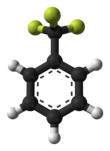| |||
| Names | |||
|---|---|---|---|
| Preferred IUPAC name
(Trifluoromethyl)benzene | |||
| Other names
Benzotrifluoride (BTF)
α,α,α-Trifluorotoluene CF3Ph PhCF3 | |||
| Identifiers | |||
3D model (JSmol)
|
|||
| ChemSpider | |||
| ECHA InfoCard | 100.002.396 | ||
| EC Number |
| ||
PubChem CID
|
|||
| UNII | |||
CompTox Dashboard (EPA)
|
|||
| |||
| |||
| Properties | |||
| C6H5CF3 | |||
| Molar mass | 146.11 g/mol | ||
| Appearance | colorless liquid | ||
| Odor | aromatic | ||
| Density | 1.19 g/mL at 20 °C | ||
| Melting point | −29.05 °C (−20.29 °F; 244.10 K) | ||
| Boiling point | 103.46 °C (218.23 °F; 376.61 K) | ||
| <0.1 g/100 mL at 21 °C | |||
| Solubility | soluble in ether, benzene, ethanol, acetone miscible in n-heptane, CCl4 | ||
Refractive index (nD)
|
1.41486 (13 °C) | ||
| Hazards | |||
| NFPA 704 (fire diamond) | |||
| Flash point | 12 °C (54 °F; 285 K) | ||
Except where otherwise noted, data are given for materials in their standard state (at 25 °C [77 °F], 100 kPa).
| |||
Trifluorotoluene is an organic compound with the formula of C6H5CF3. This colorless fluorocarbon is used as a specialty solvent in organic synthesis and an intermediate in the production of pesticides and pharmaceuticals.[1]
Synthesis
For small-scale laboratory preparations, trifluorotoluene is synthesized by coupling an aromatic halide and trifluoromethyl iodide in the presence of a copper catalyst:[2]
- PhX + CF3I → PhCF3 (where X = I, Br)
Industrial production is done by reacting benzotrichloride with hydrogen fluoride in a pressurized reactor.[3]
- PhCCl3 + 3 HF → PhCF3 + 3 HCl
Uses
Trifluorotoluene has a variety of niche uses.
Low toxicity alternative to dichloromethane
According to Ogawa and Curran, trifluorotoluene is similar to dichloromethane in standard acylation, tosylation, and silylation reactions.[4] The dielectric constants for dichloromethane and trifluorotoluene are 9.04 and 9.18, respectively, indicating similar solvating properties. Dipole moments compare less favorably: 1.89 and 2.86 D for dichloromethane and trifluorotoluene, respectively. Replacing dichloromethane is advantageous when conditions require higher boiling solvents, since trifluorotoluene boils at 103 °C it has a higher boiling point than dichloromethane, which has a boiling point of ~40 °C.
As a solvent, trifluorotoluene is useful in mild Lewis-acid catalyzed reactions, such as the Friedel-Crafts preparations. The most common catalyst, aluminium trichloride reacts with trifluorotoluene at room temperature; however, zinc chloride does not.
Synthetic intermediate
A second and perhaps more valuable use of trifluorotoluene is as a synthetic intermediate. A derivative of trifluorotoluene, 3-aminobenzotrifluoride, is the precursor to the herbicide fluometuron.[3] It is synthesized via nitration followed by reduction to meta-H2NC6H4CF3. This aniline is then converted to the urea.
Flumetramide (6-[4-(trifluoromethyl)phenyl]morpholin-3-one), a skeletal muscle relaxant, is also prepared from trifluorotoluene.[1]
Analytics
Trifluorotoluene appears in 19F NMR as a singlet at -63.2 ppm.[5]
References
- ^ a b Banks, R.E. Organofluorine Chemicals and their Industrial Applications, Ellis Horwood LTD, Chichester, 1979.
- ^ Ogawa, Akiya; Tsuchii, Kaname "α,α,α-Trifluorotoluene" in Encyclopedia of Reagents for Organic Synthesis 2005, John Wiley and Sons. doi:10.1002/047084289X.rn00653
- ^ a b Siegemund, Günter "Aromatic Compounds with Fluorinated Side-Chains" in Ullmann’s Encyclopedia of Industrial Chemistry 2005, Wiley-VCH. doi:10.1002/14356007.a11_349.
- ^ Ogawa, Akiya; Curran, Dennis P. (1997). "Benzotrifluoride: A Useful Alternative Solvent for Organic Reactions Currently Conducted in Dichloromethane and Related Solvents". Journal of Organic Chemistry. 62 (3): 450–451. doi:10.1021/jo9620324. PMID 11671431.
- ^ Denmark, Scott E.; Smith, Russell C. (3 February 2010). "Mechanistic Duality in Palladium-Catalyzed Cross-Coupling Reactions of Aryldimethylsilanolates. Intermediacy of an 8-Si-4 Arylpalladium(II) Silanolate (Supplementary Material, referenced as PhCF3)". Journal of the American Chemical Society. 132 (4): 1243–1245. doi:10.1021/ja907049y. PMC 2812642. PMID 20058920.



